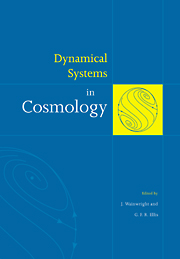14 - Cosmological density perturbations
Published online by Cambridge University Press: 10 November 2009
Summary
Over the past four decades cosmological perturbation theory has played an important role in our attempts to understand the formation of large–scale structures in the universe. So far, most of the work done in this field has been concerned with linear perturbations of the FL cosmologies, the underlying assumption being that on a sufficiently large scale the universe can be described by a homogeneous and isotropic model. A number of approaches to this problem have been presented in the literature since the pioneering work of Lifshitz, notably the gauge–invariant formulation of Bardeen (1980). Although this approach has been widely used to describe both the origin and evolution of small perturbations from the quantum era through to the time when the linear approximation breaks down, it has three shortcomings. First, the variables are non–local, depending on unobservable boundary conditions at infinity. Second, many of the key variables have a clear physical meaning only in a particular gauge. Finally, the approach is inherently limited to linear perturbations of FL models.
Recently, Ellis & Bruni (1989), building on Hawking (1966), developed a geometrical method for studying cosmological density perturbations. This approach, which is based on the spatial gradients of the energy density μ and Hubble scalar H, is both coordinate–independent and gauge–invariant, and the variables have an unambiguous physical interpretation. In addition their approach is of a general nature, because it starts from exact non–linear equations that can in principle be linearized about any FL or non–tilted Bianchi model.
- Type
- Chapter
- Information
- Dynamical Systems in Cosmology , pp. 287 - 304Publisher: Cambridge University PressPrint publication year: 1997
- 1
- Cited by



